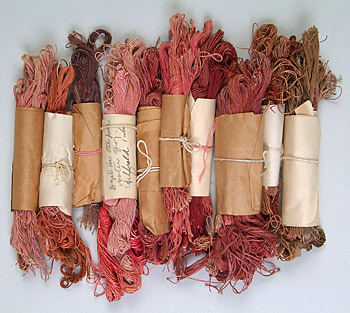Deerfield Arts & Crafts home page
Ideas
Hand Dyed Colors

© Memorial Hall Museum, Pocumtuck Valley Memorial Association
Hand Dyed Materials
Deerfield Renowned for its Hand-dyed Materials
Deerfield became famous for the distinct hues of its embroideries and baskets. In 1912, one reviewer made special note of the colors used by the Deerfield Society of Blue and White Needlework, "The thing that holds the attention at this time is the development of the wood colors in the linen fabrics. The forest holds no more beautiful tints than those that are subtly graded through the grays, ending, now in one tone, now in another, until you feel that music has no major or minors that have not their counterparts in color."1
Between 1897 and 1905 Emma Henry dyed materials for the Deerfield Society of Blue and White Needlework. Adella Andrews, who moved to Deerfield in 1902, dyed raffia for the Pocumtuck Basket Makers and thread for the Blue and White Society. Later, Margaret Whiting would take on the task of producing the blue threads that the Society needed, and Ellen Miller, through much experimentation with vegetable dyes and other natural materials, would develop the unique palette of earth tones that would color their embroideries. Margaret Whiting recalled that it was the "beautiful and permanent dyes Ellen Miller learned to produce," which made the Blue and White Society's hand-dyed hues such a success, as "No one without the rare capacity for scientific study and the still rarer sense of true color could have become, as she did, the chief expert in this country in the use of dyestuffs from natural, rather than chemical sources."2
- The Springfield Daily Republican, July 10, 1912.
- Margaret Whiting, "Ellen Miller," History and Proceeding of the Pocumtuck Valley Memorial Association 1930-1938, Vol. VIII (Deerfield, MA: 1950) 7.